Mackinac Island is blessed with a number of natural springs which percolate through limestone bedrock. An 1882 tourist booklet, Mackinac Island, Wave-Washed Tourists’ Paradise of the Unsalted Seas, boasted of “living streams of pure water, cooled down to the temperature of forty-four degrees, gushing from its lime-rock precipices.” A few of these, such as Dwightwood Spring and Croghan Water, are well known by many of today’s visitors. Others, such as Wishing Spring, Wawatam Brook, and La Salle Spring, are less familiar or forgotten. When you do encounter a natural spring, please enjoy the view, but remember untreated water is considered unsafe for drinking.
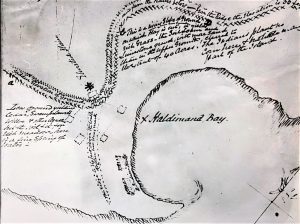

A Fine Spring
As the British settled Mackinac Island from 1780-1781, water was viewed as a valuable resource. Lieutenant Governor Patrick Sinclair noted “a fine spring of water” on a map he drew after visiting the island in 1779. He wrote his superiors, “Our Village will be washed on one side by a fine Spring which with some care may be brought to turn a mill at least one day in seven.”
More pressing priorities meant Sinclair never built his water-powered mill on Mackinac Island. The spring he referred to once fed a small trickle of water named Wawatam Brook for 20th century guidebooks. The brook originated near the Grand Hotel and emptied into a small lake now called Hanks Pond, which serves a water feature on the Jewel Golf Course.
La Salle Spring
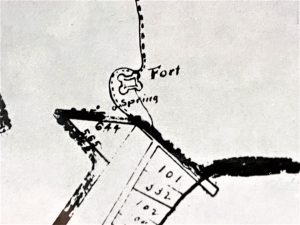

A second natural spring once trickled into Hanks Pond, originating below Fort Mackinac’s West Blockhouse. Eventually christened La Salle Spring, it became a reliable source of water for Island residents and soldiers alike. In his 1895 book, Mackinac, Formerly Michilimackinac, Dr. John R. Bailey noted that log piping was used for feeding water to town, supplying “stores, warehouses, and dwellings of the fur company.”
In 1881, a steam-powered pump was installed which elevated water from the spring through ½ inch lead pipes to a reservoir located in the second story of the North Blockhouse. From this high point, it then flowed through pipes into various fort buildings. In Annals of Fort Mackinac, author Dwight H. Kelton enlightened his readers, “This innovation on the old-time water-wagon was made… in accordance with a plan devised by, and executed under the direction of Lieut. D.H. Kelton, Post Quartermaster. Water was first pumped October 11, 1881.”
Croghan Water
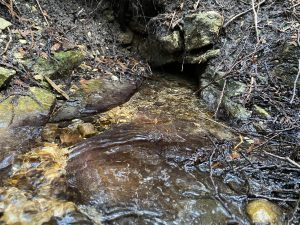

The north-central portion of Mackinac Island once featured the Island’s largest farm. By 1804, Michael Dousman harvested hay, raised cattle, and even built a horse-powered mill and distillery there. In 1814, the Battle of Mackinac Island was fought on Dousman’s hay fields. Today, links of the Wawashkamo Golf Club cover much of the site.
Dousman’s distillery was situated near a flowing spring of cool water. On early maps, it was simply labeled “Cold Spring.” In 1913, the spring was renamed Croghan Water, in honor Colonel George Croghan, commander of American forces during the 1814 battle.
Wishing Spring
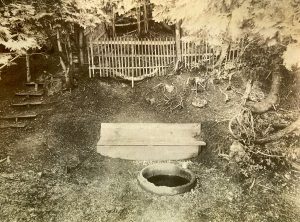

This spring was the first which became a popular tourist destination. Once located near Devil’s Kitchen, it was also known as Lover’s Rest or Fairy Spring. During her 1872 visit to the site, novelist Constance Fenimore Woolson offered a token knot of ribbon and wished for health during the year.
Rev. Frank O’Brien summarized the site in the 1916 guide, Names and Places of Interest on Mackinac Island, Michigan. He wrote, “This Wishing Spring is within a fragrant, fairy grotto. The water, clear as crystal, flows from above, dripping, cool and refreshing. If you drink and wish, and keep the secret for three days, tradition says you will get whatever you wish.”
Dwightwood Spring
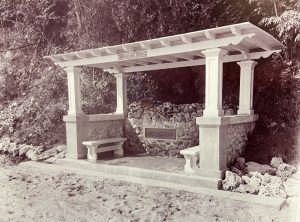

This well-known spring is located along Lake Shore Boulevard (M-185), near the southeast corner of Mackinac Island. In 1909, Edwin O. Wood donated funds for a canopy, fountain, and benches in memory of his son, Dwight Hulbert Wood, who perished after his bicycle was struck by a horse-drawn fire engine in Flint, Michigan.
That July, a dedication ceremony was held to christen Dwightwood Spring. During the ceremony, park superintendent Benjamin Franklin Emery noted the site was dedicated “to preserve the work of nature, to make the spring accessible, to prove a shelter in time of storm, to be a resting place for the weary, long to be remembered after leaving the beautiful Island shores.”
An Invitation
The springs above represent just a few of Mackinac Island’s “living streams of pure water” which bubble up from its limestone bedrock. During your next visit, you’re invited to seek out these peaceful places, enjoy their quiet beauty, and discover special plants and animals that thrive there. Perhaps, like Ms. Woolson, you’ll feel inspired. “Now I am a sensible, middle-aged woman,” she wrote, “but something in the moonlight bewitched me, and I consented, much to the delight of my niece.”








